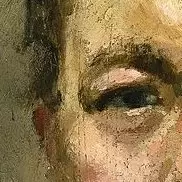From the moment of his arrival in Arles, on 8 February 1888, Van Gogh was constantly preoccupied with the representation of “night effects”. In April 1888, he wrote to his brother Theo: “I need a starry night with cypresses or maybe above a field of ripe wheat.” In June, he confided to the painter Emile Bernard: “But when shall I ever paint the Starry Sky, this painting that keeps haunting me” and, in September, in a letter to his sister, he evoked the same subject: “Often it seems to me night is even more richly coloured than day”. During the same month of September, he finally realised his obsessive project.
He first painted a corner of nocturnal sky in Cafe Terrace on the Place du Forum, Arles (Otterlo, Rijksmuseum Kröller-Muller). Next came this view of the Rhône in which he marvellously transcribed the colours he perceived in the dark. Blues prevail: Prussian blue, ultramarine and cobalt. The city gas lights glimmer an intense orange and are reflected in the water. The stars sparkle like gemstones.
A few months later, just after being confined to a mental institution, Van Gogh painted another version of the same subject: Starry Night (New York, MoMA), in which the violence of his troubled psyche is fully expressed. Trees are shaped like flames while the sky and stars whirl in a cosmic vision. The Musée d’Orsay’s Starry Night is more serene, an atmosphere reinforced by the presence of a couple of lovers at the bottom of the canvas.
https://www.musee-orsay.fr/en/artworks/la-nuit-etoilee-78696


Thanks, I’ll update the title. The site is in French, and says its “La Nuit étoilée” (The Starry Night), but perhaps there was an error.